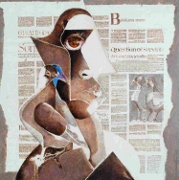In showcasing his work to both an informed and learned audience, viewing the work of internationally acclaimed artist Jamil Naqsh originates particular elucidation. The frames of reference appear from a deeply sourced phenomenon, seemingly freely and dramatically blending allusions to the roots of his artistic heritage, with the refinement of the school of classic miniature art. These elements are interwoven with the immediacy of his times in the form of Cubism and Abstraction. Manipulating the forms of the preeminent pigeons, faces and female figures portrayed is the amalgamation between sharp angles and voluptuous curves.
The modern master, Jamil Naqsh, was a boy when he left his home in Kairana, India to live in Pakistan. In his early teens he travelled alone through Chittagong, Calcutta and Colombo. A medley of impressions and a great respect for the art traditions of the past was a gift of the young man’s journey, factors that were to influence his life, his work and his creative mind-set. As an art student in 1953, he absorbed the aesthetics of modern art but he was determined to make a comprehensive analysis of the numerous schools of traditional miniature paintings. Thus he sacrificed the ease of an art student’s life to become a devotee of master miniaturist Ustad Mohammed Sharif. Obsessed with the idea of ‘line’, the young artist sought a philosophy that focused on his work in the years to follow.
Recently Islamabad’s Tanzara Art Gallery held a solo show titled ‘Bird of Time’ by Naqsh. There are 23 exquisite canvases (oil on canvas) from this series including 10 graphite drawings of the female form. This is his way of paying tribute to his early painting days by creating a nostalgic reflection of the familiar imagery that art lovers have seen in preceding years. By creating enthralling images of newspapers as backdrops on his surfaces, Naqsh paints his pigeons, old buildings especially those from the Mughal era, faces and in some the local in order to refabricate the mesmerising phantasmagorias of his past. His style of combining the two schools of thought, the technique the European masters used and traditional methods of Mughal miniature painting integrate beautifully together. There are effective traces of his inspiration from the work of Italian sculptor Marino Marini that are evident in this show besides his first solo show in London at the Albemarle Gallery. Naqsh is fond of Picasso and French Neo-Classicist Jean Dominique Ingres. His vision from the latter plays an important role in his style of Mughal miniature painting due to Ingres’s orientalist tendencies.
Naqsh’s paintings of female nudes have an extraordinary and unprecedented almost apparent sculptural malleability that they invite the viewer to touch and feel them. Pigeons have a deep personal meaning for Naqsh because as a young boy in his family home he would see them flying around the courtyard and through open windows. For him they offer a sentimental remembering of his childhood memories. Naqsh paints what he loves, the people he feels devoted to and loves, his cherished thoughts and places close to him. These reminiscences are disseminated into a representation of familial congruence. By moulding the female forms, pigeons, places and backdrops of newspapers Naqsh produces a wondrous world of movement and harmony with subtle colours, line and brush-work. He manipulates his surface with an imaginative flair, and his compositions are engaged sensitively.
Naqsh’s graphite drawings are also a pleasure as he draws the female figures in a sensuous manner merging his forms in a bold linear method. The forms maintain a sculpturesque quality, the females are stylised, voluptuous and sensual. Naqsh’s triumph with graphite on paper is over-whelming; the forms seem to be expanding taking over the page, the limbs twist and turn in some while the line work and strokes reveal the energy being embedded onto each surface. He has an extraordinary command in handling light and shade with variations of tone and colour from light to dark. His forms are broken into various segments that could bewilder an onlooker coercing him or her to pay careful attention to the drawing itself.
Naqsh converses with his skills where lines and colour, form and texture mix in an environment of conceptual interpretation to create a corresponding network with his viewers. Being a part of this show as the audience is distinctively a visual treat!




